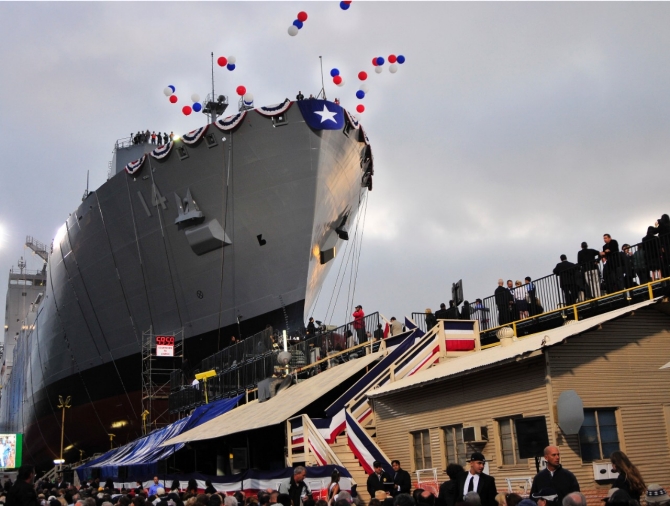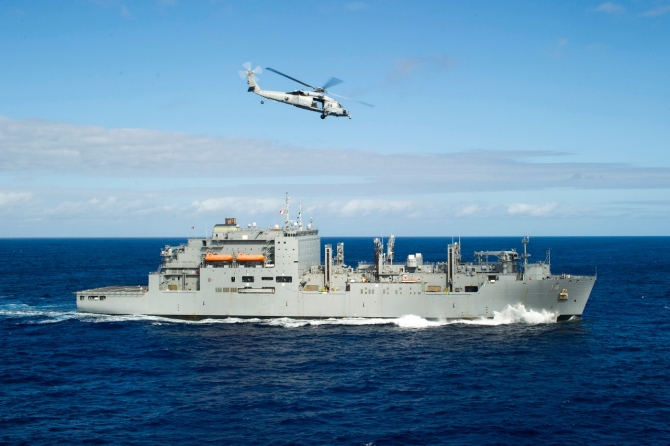Cesar Chavez (T-AKE-14)
2012–
First U.S. Navy ship named in honor of Cesar Estrada Chavez who was an American farm worker, labor leader, civil rights activist and co-founder of the United Farm Workers Union.
Cesar Estrada Chavez was born 31 March 1927 in Yuma, Ariz. His family owned a grocery store and a ranch in the area; however they were lost during the Great Depression. Afterwards, his family then moved to Calif. to become migrant farm workers.
In 1942, Chavez left school while in the seventh grade to become a full-time migrant farm worker. In 1944 he enlisted in the U. S. Navy at the age of seventeen and served for two years.
After being discharged at the close of World War II, Chavez worked in the fields until 1952 when he became an organizer for the Community Service Organization (CSO), a Latino civil rights group. He later became CSO's national director in 1958.
In 1962, Chavez left the CSO and co-founded the National Farm Workers Association (NFWA) with Dolores Huerta. It was later renamed the United Farm Workers (UFW). In the early 1970s, the UFW organized strikes and boycotts including the Salad Bowl strike which was the largest farm worker strike in U.S. history. It was a wage protest for migrants working for grape and lettuce growers.
During Chavez's tenure, the UFW was committed to restricting immigration and actively fought the Bracero Program that existed from 1942-1964. His opposition stemmed from the belief that the program undermined U.S. workers and exploited the migrant workers. Since the program ensured a constant supply of cheap immigrant labor for growers, immigrants could not protest any infringement of their rights for the risk of being fired and replaced. His efforts contributed to Congress ending the Bracero Program in 1964.
In 1969, Chavez and members of the UFW marched through the Imperial and Coachella Valleys to the border of Mexico to protest growers' use of illegal aliens as strikebreakers. Joining him on the march were Reverend Ralph Abernathy and U.S. Senator Walter Mondale (D-Minn.). In its early years, the UFW and Chavez also reported illegal aliens who served as strikebreaking replacement workers to the Immigration and Naturalization Service.
In 1973, the United Farm Workers set up a line along the United States-Mexico border in order to prevent Mexican immigrants from entering the U.S. illegally and potentially undermining the UFW's unionization efforts. During one such event some UFW members physically attacked the strikebreakers after peaceful attempts to persuade them not to cross failed. Also that year, the UFW was one of the first labor unions to oppose proposed employer sanctions that would have prohibited hiring illegal aliens. Later during the 1980s, Chavez was crucial in gaining amnesty provisions into the 1986 federal immigration act.
Driven by the election of the pro-union Jerry Brown as governor of California and a costly battle with the Teamsters union over the organizing of farmworkers, Chavez decided to try to work toward legal victories. On 4 June 1975, Governor Brown signed into law the California Agricultural Labor Relations Act (ALRA), which established collective bargaining for farmworkers. The act set up the California Agricultural Labor Relations Board (ALRB) to oversee the process.
In 1977, Chavez attempted to reach out to Filipino-American farmworkers. He met with then Philippine President Ferdinand Marcos in Manila and endorsed the regime. His meeting angered many human rights advocates and religious leaders who viewed Marcos as a cruel dictator.
In the 1980s, with the UFW declining, Chavez transitioned into real-estate development. Several of the projects he was involved with used non-union construction workers.
Chavez passed away on 23 April 1993 in San Luis, Ariz. He is interred at the National Chavez Center in Kern County, Calif.
(T-AKE-14: displacement 35,400; length 689'; beam 106'; draft 29'; speed 20 knots; complement 124 civilian, 50 active duty; class Lewis and Clark)
Cesar Chavez (T-AKE-14) was laid down on 10 May 2011 at San Diego, Calif., by National Steel & Shipbuilding Company; and launched on 5 May 2012. She entered non-commissioned U.S. Navy service with the Military Sealift Command (MSC) with a primarily civilian crew on 25 October 2014. She serves in the United States Pacific Fleet.


Detailed history pending.
Paul J. Marcello
28 January 2016


